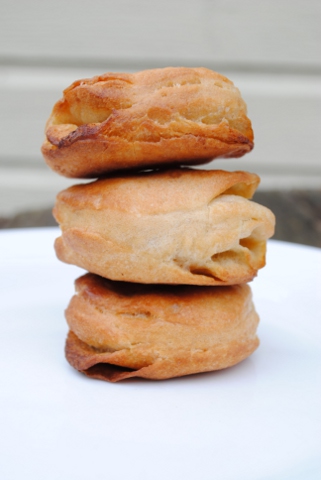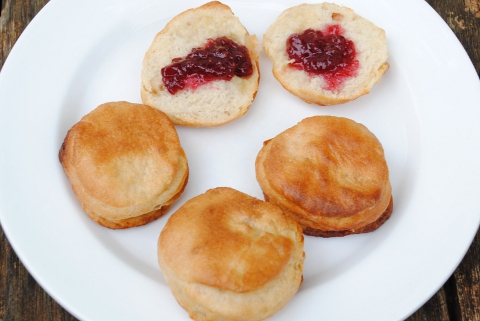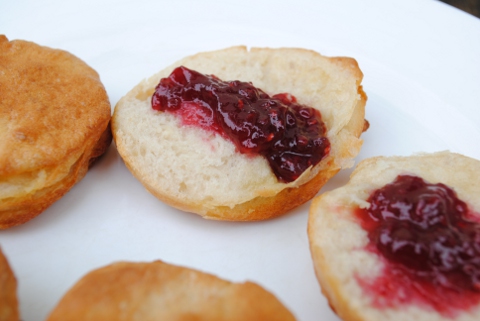Full butteries
Aberdeen butteries, also known as rowies, are rather like rustic croissants: flaky like their continental relatives but not as delicate or rich, and round or oval in shape. They’re made using more or less the same technique of rolling out yeasted dough, dotting the sheet with hard fat (traditionally a mixture of butter and lard) and then folding it by thirds into a package which is then turned, rolled out again, and the procedure repeated. The folding and rolling is done two to four times in total, depending on the recipe, creating numerous sheets of dough separated by layers of fat – what bakers call a laminated dough. During baking the fat melts and releases steam, causing the sheets of dough to separate slightly to give the flakiness associated with croissants and Danish pastries. It’s the same process by which puff pastry is made, except in yeast-leavened form. Folklore has it that butteries were created for Scottish fishermen looking for an alternative to the hard ship’s biscuits that formed the sailor’s staple diet for so long because they kept well during long spells afloat. The high fat content helped the butteries keep longer without staling although, for the same reason, they would not have lasted as long as ship’s biscuit. As unpalatable as ‘hard tack’ was, it couldn’t be bettered for longevity, even if weevils frequently competed with humans to consume it.
Folklore has it that butteries were created for Scottish fishermen looking for an alternative to the hard ship’s biscuits that formed the sailor’s staple diet for so long because they kept well during long spells afloat. The high fat content helped the butteries keep longer without staling although, for the same reason, they would not have lasted as long as ship’s biscuit. As unpalatable as ‘hard tack’ was, it couldn’t be bettered for longevity, even if weevils frequently competed with humans to consume it.
Regardless of their origins, the buttery or rowie became popular as breakfast fare in Scotland, though it’s not often found in the rest of the UK – which is a pity, because rowies have much to commend them. The recipe I’ve settled on has been cobbled together from several different versions. The main modification I’ve made is to reduce the fat: most recipes for laminated doughs seem to contain far too much, so that more of it ends up flooding baking sheets and tins than in the baked goods themselves.
The recipe I’ve settled on has been cobbled together from several different versions. The main modification I’ve made is to reduce the fat: most recipes for laminated doughs seem to contain far too much, so that more of it ends up flooding baking sheets and tins than in the baked goods themselves.
340g strong white flour
210g water
5g salt
15g fresh yeast/7g fast action or easy blend
85g butter, or lard and butter combined, diced
Make a dough with the flour, water, salt and yeast, knead for 10 minutes and bulk ferment for about an hour, until doubled in size.
Once risen, roll the dough out into a rectangle roughly 25cm by 15cm. Use a third of the diced fat to dot two thirds of the rectangle. Now fold the uncovered third over the middle third, and the remaining piece over the top of that, taking care that the diced fat doesn’t escape (I press it gently into the dough to anchor it there). Gently seal the seams with your fingertips and then wrap the dough in clingfilm or greaseproof paper and chill it in the refrigerator for 10-20 minutes. Once chilled, repeat the process of rolling and folding, each time turning the dough 90°.
Although a little fiddly and time-consuming, all this rolling and folding isn’t that difficult. The main thing to remember is that you are not creating a work of art: your rectangles don’t need to be perfectly rectangular and your thirds don’t need to be perfect thirds. Once the rolling and folding is done, divide the dough into ten pieces and use a rolling pin to form rounds or ovals about 2cm thick and 10-12cm across. I made the butteries pictured here smaller than usual and stamped them out with a biscuit-cutter, just for a change. Arrange them on baking sheets and bake in an oven preheated to 200°c for 15-20 minutes, turning them over halfway through.
Once the rolling and folding is done, divide the dough into ten pieces and use a rolling pin to form rounds or ovals about 2cm thick and 10-12cm across. I made the butteries pictured here smaller than usual and stamped them out with a biscuit-cutter, just for a change. Arrange them on baking sheets and bake in an oven preheated to 200°c for 15-20 minutes, turning them over halfway through.
Butteries keep fairly well, and can be reheated in a low (100°c) oven for five minutes or so. Just split and serve with jam.

December 10, 2021 @ 5:04 pm
Sorry these just don’t look like rowies. In no way would you be able to cut one in half, as here, to spread jam on one. Also the insides should brown and densely flaky. They are the same colour all the way through. I’m afraid you really do need all the fat that you see in other recipes and then work out a way of baking them without too much fat coming out. In addition they should be about 4-5 inches across, flat on the bottom (where you can spread jam or what ever if you want) then roughly indented on the top. They are not turned over halfway through.
December 11, 2021 @ 12:13 pm
Indeed so (although I did note in the post that they are normally larger). The post is quite a few years old and was one of my early experiments (the blog has fallen by the wayside due to other commitments). I’m still not convinced about the fat, though – not just in rowies but in most recipes for laminated doughs.